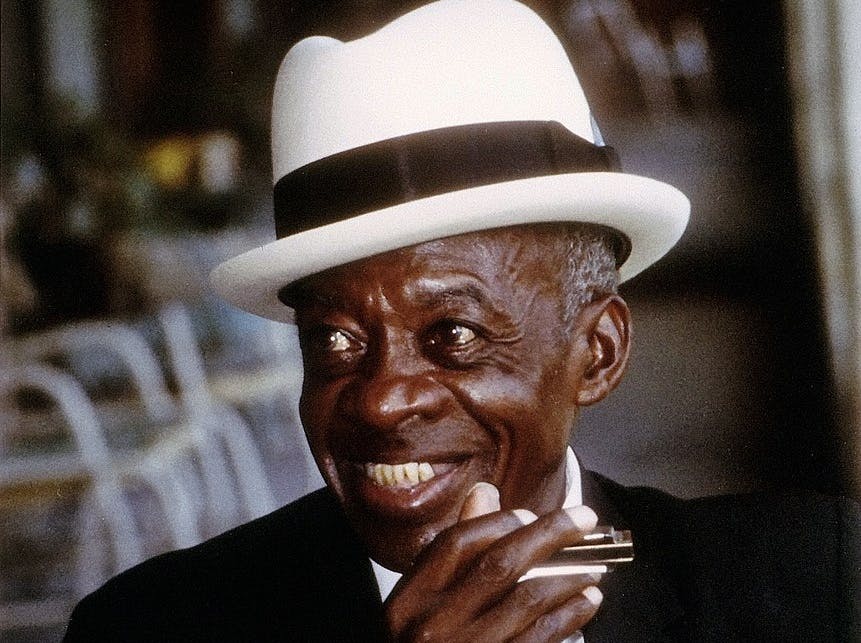Reviving Opryland’s Black Star
The biographer had no idea that his work would not only revive the reputation of DeFord Bailey but contribute to his belated election to the Country Music Hall of Fame in 2005.

‘DeFord Bailey: A Black Star in Early Country Music’
By David C. Morton
Foreword by Dom Flemons
University of Illinois Press, 224 pages
I’m listening to DeFord Bailey play “Pan American Blues” on his harmonica. What I am experiencing is not only a steam train chugging faster and faster, and whistling its way to another world, but a visceral, exhilarating sense of the past itself vibrating through my body.
When biographer David C. Morton in the 1970s set out to do an article on the forgotten Black Grand Ole Opry star, and one of its founding artists, who was still alive and occasionally performing, the biographer had no idea that his work would not only revive the reputation of a great artist but contribute to his belated election to the Country Music Hall of Fame in 2005.
Bailey’s obscurity had to do with his sudden departure from the Opry in 1941, followed by sporadic appearances — mostly in Nashville, where he lived — and with his reluctance to perform or discuss his remarkable career.
Bailey had been a radio star and a favorite of audiences, Black and white, and especially of his fellow musicians, including the legendary Roy Acuff, called the “king of country music,” and Bill Monroe, the “patriarch of bluegrass music.”
At the Opry and on the road, Bailey became the honored and trusted member of what then — in the 1920s and 1930s — was an exclusively white performing company. Less than five feet tall, and partially disabled by childhood polio, Bailey was treated as an equal by fellow performers and rarely had any trouble with whites while traveling through the South.
Bailey had known hard times and his family feared he would never be able to be independent. He prevailed, mastering not only the harmonica, but also the guitar and banjo. He sang as well. Over several decades he perfected a unique style that made his renditions of standard country and blues songs innovative.
Nothing deterred Bailey: not the Depression, not traveling on dark country roads carrying a pistol — mainly, he said, because if the car broke down in the middle of night, who knows what wild animals might be lurking?
In 1941, when Bailey’s Grand Ole Opry employers told him that he would have to start performing new material because of concerns about violating copyrights of the traditional tunes he played, he balked. His art and his instruments were the labor of a lifetime he would not forsake.
So Bailey no longer appeared at the Opry — also aggrieved because he was not paid the same rate as white performers. During the Depression he had already taken pay cuts, electing to pursue other successful businesses such as shoe shining and accommodating Blacks and whites in his house.
Bailey lived into his early 80s. After Mr. Morton discovered him, a reluctant Bailey slowly opened up, sharing with the biographer photographs that appear in this book, as well as allowing Mr. Morton to record songs that Bailey had never performed in studio sessions.
An immaculate dresser, with more than 40 suits in his wardrobe when he died, Bailey was a devout Christian, pater familias, and a shrewd judge of his own talent and worth. In his later years, he rejected many offers to perform — notably in one instance refusing to play unless he was paid as much as Johnny Cash.
Bailey knew he was a star even when he labored in obscurity. He never felt he had to prove himself. His reflections on life come through in this poignant biography, first published in 1991 and now reissued in paperback under the auspices of the Country Music Foundation Press, with a foreword by musician Dom Flemons testifying to the continuing appeal of Bailey’s exemplary life and thrilling music.
How Mr. Morton coaxed DeFord Bailey to talk about his life and music is a crucial part of this biography, since it reveals how the very process of getting Bailey to talk about his life inspired the artist to realize why it was so important to preserve a legacy that he was proud of but did not seem to realize, without Mr. Morton’s intervention, that Bailey could restore much of what had been lost when he departed from the national country music scene in 1941.
Mr. Rollyson is the author of “American Biography.”

